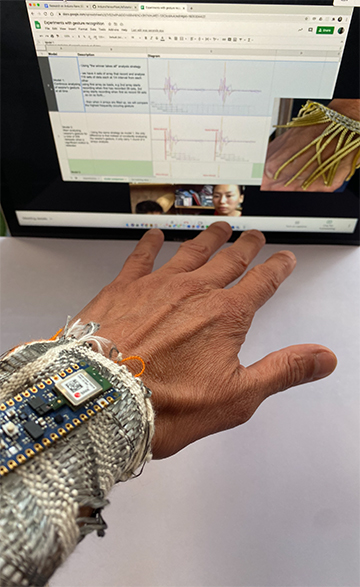Talking with the machine Part I: Embodied Companion
embodied companion is a project developed in collaboration with Umbrellium and funded by the HDI Network,
The project Embodied Companion aims to reframe existing relationships to machine learning and technological artifacts. Approaching machine learning as an intra-active process that moves beyond quantification and the instrumentalization of embodied experiences and expression, the project proposes the development of new frameworks in which to explore machine learning and human-data interaction.
As such, the project’s objective is to expand on the vocabulary used to describe human-data interactions and engage with machine learning as a space of experimentation that builds on multiple input streams and acknowledges the complexities of both human and machine expressivity and intentionality.
Embodied Companion attempts to create a discursive relationship between machine learning and humans, one that is centered around nuance, curiosity and second order feedback loops. Using machine learning to not only train and “learn” human behaviours but create a symbiotic relationship with a technological artifact that rests on a mutual progression of understanding, the project aims to embody and make legible machine learning processes and shed some light on the algorithmic black box.
We are particularly interested in working with machine learning in such a way as to compose these building blocks as both intuitive and explicit, much like the ways in which self-directed and social gestures function (Flusser, 1991, Agamben, 1992).
While machine learning is generally based on the detection of patterns, predictability and probabilistic models, we are keen to explore machine learning, using our existing scarf as platform, as a space where human-data interaction and inputs is nuanced and challenges the quantified and reductivist approaches around the decipherability of human expression.
As algorithms increasingly affect more and more aspects of human life, from justice and policy decisions, romantic relationships, employment –the list goes on and on, as Surveillance Capitalism (Zouboff, 2019) consolidates its grip, and biases are perpetuated and reinforced and so aptly demonstrated in Excavating AI by Crawford and Paglen, (2019), it appears that it is algorithms that train humans and not the other way around
In this environment, where machines mimic humans that mimic machines, fundamental questions around what it means to be human, the expanding role of artificial intelligence(s), and in fact the very notions of artificiality and intelligence, acquire a renewed urgency.
The rate of technological change outpaces exponentially that of social arrangements, policy and ethics and in turn creates an unbalanced relationship between artificial and human intelligence. In the process, the algorithmic proverbial black box only gets darker and more impenetrable, further removed from material surfaces and embodied interactions.
The project moves away from solely digital representations, or ones that rest on robotic principles, but instead uses machine learning to develop an embodied character in the form an inhabited technological artifact.
We therefore approach the discursive relationship that co-evolves as the basis of the system’s legibility and one that demands an active and intentional engagement –where machinic behaviours co-emerge with human ones, actuated on a material surface. In such a process we also explore notions of radical presence as to challenge machine learning systems where the future is predicated on the past.
Our intention is not to anthropomorphise artificial intelligence, nor claim the possibility of an emotional life in the machine or even an emotional attachment to one. Instead, we believe that by using machine learning to develop a nuanced and yet intentional relationship between human and machine, we are opening up the expressive and creative affordances of human-data interactions with artificial intelligence(s).
At the same time, by developing a relationship between a machine learning system that carries some of the characteristics of intimacy, we explore legibility and even agency in a personal system that is private and rests only on data shared between the two actors (human & machine).
In this framework legibility is not made possible by the way the system is configured, but the system’s very existence and success –the emergence of an intra-active relationship, is based on how well the two actors can read each-other and can render their intra-action legible for the other.
Here, we place emphasis on the embodied character of our project and the use of machine learning to develop an active and possibly unpredictable and serendipitous relationship, despite the apparent paradox that this presents when accounting for the goal driven nature of machine learning and artificial intelligence systems. Yet, we believe that in exploring ways to address such paradoxes we create an opportunity for expanding the gestural and conversational pitch of human-data interactions.
In addition, Embodied Machine Learning explores ways in which a theoretical framework of intra-activity, respons-ability, relationship with non-human intelligences and applied ethics can be articulated and made present in machine learning systems. Tthe terms intra-activity, respons-ability are coined by the physicist and philosopher Karen Barad and we are keen to explore these philosophical terms in their material manifestation and in the process question and engage with new materialism as an unfolding process of making, and technological artifacts as “theory-objects,” or what Andrew Pickering refers to ideas as engaged practice expressed in a series of real-world projects encompassing “strange machines and artifacts, material and social” in his compelling survey of the British cybernetic tradition and some of its key figures.[1]
Our process is based on an incremental and iterative cycle of thinking and making, where we test theoretical constructs and explore ways in which they can be made manifest materially and algorithmically.
The outcome of the project for this phase is meant to serve as a platform on top of which we can keep building and exploring additional thematic layers, based on our approach to machine learning as fundamentally a conversational and, hopefully, open system.
[1] Andrew Pickering, The Cybernetic Brain: Sketches of Another Future (Chicago ; London: University of Chicago Press, 2010).
